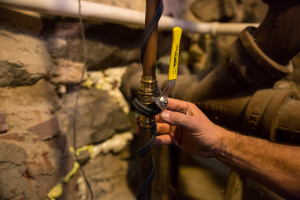Heating costs are a significant expense for many households, especially during colder months. If you’re wondering how to save on heating bills, improving your home’s energy efficiency is the key.
By adopting smart solutions like radiant floor heating, upgrading to smarter thermostats, and sealing drafts, you can reduce energy usage without sacrificing comfort. This guide will help you identify practical and long-term strategies to keep your home warm while effectively lowering your energy expenses.
How to Save Money on Heating Bills in the Short Term
Setting your home up to be more energy-efficient will not only save you money during the winter but also make your home more comfortable year-round.
1. Ensure That Your Home Is Properly Insulated
Insulation is crucial for maintaining comfortable indoor temperatures throughout the year. If your home is not well-insulated, heat escapes through the walls, floors, and ceilings, forcing your system to work harder and increasing your energy bills.
Signs of Poor Insulation:
- High energy bills during the winter.
- Fluctuating indoor temperatures.
- Drafts or indoor condensation on windows.
While installing new insulation is the ideal solution, there are cost-effective measures you can take in the short term:
- Use Thermal Curtains: These act as an extra layer of insulation, blocking drafts and keeping warmth inside.
- Insulate Electrical Outlets and Switches: Foam gaskets or spray foam behind outlets and switches can reduce heat loss.
- Seal Windows and Doors: Add weatherstripping or recaulk to close gaps.
- Insulate the Attic: Adding insulation to your attic can help regulate your home’s temperature.
- Insulate HVAC Ducts: Seal cracked or broken ductwork to minimize heat loss.
- Insulate the Floors: Warmup’s Ultralight™ Insulation Boards or Insulated Underlay are excellent options for radiant floor heating systems.
2. Replace Old Windows
Older windows are often less energy-efficient due to outdated materials like single-pane glass. Replacing them with ENERGY STAR-certified options featuring Low-E glass improves insulation, prevents drafts, and helps maintain consistent indoor temperatures. While replacing windows is an investment, the energy savings and increased home comfort can be well worth it.
3. Lower Your Thermostat
Lowering your thermostat by just 1°F for 8 hours can save up to 1% on your annual heating bill. By reducing the temperature by 7°-10° overnight or when you’re away, you can save up to 10% annually, according to the U.S. Department of Energy. Radiant floor heating systems pair perfectly with lower thermostat settings since they deliver consistent, even warmth at lower temperatures.
4. Install a Smart Thermostat
Smart thermostats are a game-changer for energy efficiency, offering precise control of your home’s temperature. You can schedule temperature changes, adjust settings remotely via smartphone, and integrate with zonal heating systems.
Warmup Smart Thermostat Options:
- 6iE Smart WiFi Thermostat: Features a smartphone touchscreen, energy-monitoring tools, and compatibility with Amazon Alexa. This advanced thermostat can save you up to $500 annually on your heating bill.
- Terra WiFi Thermostat: A user-friendly option with intuitive controls for efficient heating management.
Smart thermostats can reduce overall energy usage by up to 25%, making them a worthwhile investment for energy savings.
5. Change Your Air Filters
Regularly changing air filters is essential for forced-air systems, such as heat pumps and furnaces. Clogged filters reduce system efficiency, leading to higher energy consumption and poor air quality. Replace filters every 30-90 days, depending on usage and manufacturer recommendations, to ensure peak performance and lower heating costs.
How to Save on Heating Costs in the Long Term

While short-term solutions are effective, making long-term changes to improve energy efficiency can lead to significant savings over time.
6. Replace Your Heating System
If your furnace is over 15 years old or your heat pump is more than 10 years old, replacing them with modern energy-efficient systems can dramatically reduce heating costs. Options include:
- Ground or Air-Source Heat Pumps: Ideal for sustainable heating with lower operating costs.
- Biomass Boilers: Use organic materials for an eco-friendly heating option.
- Solar Thermal Systems: Generate heat using solar energy, reducing reliance on traditional energy sources.
Upgrading your heating system may involve upfront costs, but the energy savings and reduced environmental impact make it a smart investment.
7. Add Radiant Floor Heating
Radiant floor heating is an excellent supplemental heating system that offers unparalleled energy efficiency. Installed beneath your flooring, radiant heating uses infrared energy to warm a space from the ground up, reducing heat loss and operating at lower temperatures.
Benefits of Radiant Floor Heating:
- Efficiency: Radiant systems are up to 40% more efficient than traditional forced-air systems.
- Comfort: Even, consistent warmth eliminates cold spots and drafts.
- Quick Heating: Radiant systems reach optimal temperatures in about 20 minutes, reducing energy use.
Zonal Heating: Optimize Energy Use Room by Room
Zonal heating is one of the most effective ways to reduce energy costs by heating only the areas you use. Unlike traditional systems that heat the entire house evenly—often wasting energy on unoccupied spaces—zonal heating allows for precise temperature control in specific rooms or zones.
Radiant floor heating systems, like those offered by Warmup, are perfectly suited for zonal heating. Each room can be equipped with an independent thermostat, giving you the flexibility to heat only the areas that are occupied. For example, you can keep your living room warm during the evening while reducing heating in bedrooms until bedtime, maximizing comfort and efficiency.
Pairing Warmup’s radiant floor heating with smart thermostats, such as the 6iE Smart WiFi Thermostat, further enhances zonal control. These thermostats allow you to program schedules for each zone and adjust settings remotely via a smartphone, ensuring optimal energy use even when you’re away.
Warmup Radiant Heating Options:
- DCM-PRO System: Compatible with various flooring types, from tile to vinyl.
- StickyMat System: Ideal for quick and easy installations.
- Foil Heater System: Specifically designed for laminate, floating engineered wood, and carpeted floors.
- In-Slab Cable System: Designed for use on concrete floors.
Radiant floor heating pairs perfectly with smart thermostats and zonal controls, allowing you to heat only the spaces you use. With the combination of radiant heating and zonal control, you can reduce energy waste, lower your heating bills, and enjoy tailored comfort throughout your home.
Stay Warm and Save Money
Saving money on heating bills is achievable through a combination of short-term fixes and long-term investments. Whether it’s sealing drafts, upgrading to energy-efficient windows, or installing radiant floor heating, these solutions can lower your costs and make your home more comfortable.
Explore Warmup’s innovative heating solutions and take the first step toward energy efficiency. Contact us today for more information or if you’re ready to get started, get a quick quote.




![Thumbnail [200x250]](/wp-content/uploads/Indoor-Systems-Page-Image.png)
![Thumbnail [200x250]](/wp-content/uploads/image-13.png)
![Thumbnail [200x250]](/wp-content/uploads/Projects-Image.png)